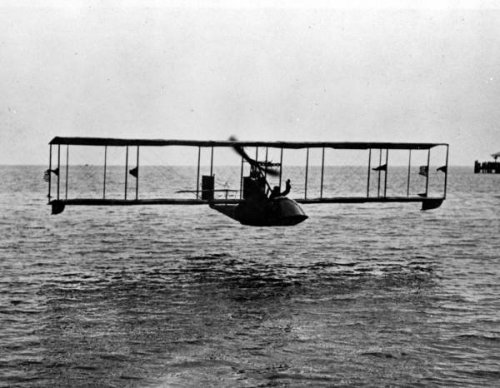Tom Benoist
Today, we invent the airline. The University of Houston's College of Engineering presents this series about the machines that make our civilization run, and the people whose ingenuity created them.
According to Yahoo, the trip from St. Petersburg, Florida, across the Howard Frankland Bridge to Tampa, should take 23 minutes. But many people got there in that same 23 minutes, way back in 1914. That New Year's day, just before 10:00 AM, former St. Petersburg Mayor A. C. Pheil carefully stepped into the cockpit of a Benoist Model XIV flying boat, next to pilot Tony Jannus. They flew to Tampa, returned at eleven, and left their names in the history books. This was the first flight of a commercial airline.
That traces to Tom Benoist, born in the town of Irondale, Missouri in 1875. Benoist studied soaring birds of prey in the Ozarks as a child. and was deeply fascinated with flight. He finished grade school; then some night school, and he studied on his own.
In 1907, less than four years after the Wrights flew, Benoist and a partner opened the Aeronautical Supply Company in St. Louis. That may sound crazy, but the business succeeded since St. Louis was a crossroads. It attracted many earlier fliers.
The 1904 Louisiana Purchase Exposition had already featured rides on small dirigibles. By 1910, Benoist was selling full-sized kits for flying machines. You could build your own biplane Glider or Santos Dumont monoplane. And he opened a flying school. In 1912 he unveiled his first flying boat design on Creve Couer Lake.
A year later, an engine company representative named Percival Fansler sold St. Petersburg on creating air service to Tampa. He ordered three Benoist aeroplanes -- a Model XIII to train pilots and two Model XIVs for passengers. The first arrived by train from Paducah in time for a dramatic New-Year's-day launch.
The fare would be five dollars, a lot of money then. But Pheil had bid four hundred dollars at an auction to be the first passenger. The money went toward installing harbor lights. In all, 1205 people crossed Tampa Bay -- one passenger per flight. The service had been completely safe and passengers saved themselves, not a 23-minute drive, but a twelve-hour train ride.
Yet the service ended only four months later. Why should such a good thing fizzle that way? The obvious reason was that it didn't turn enough profit. But there was more to it: The pilots had grown bored going back and forth, back and forth. They'd amused themselves by racing the two planes against each another, and they'd done some charter work. But their main task was done.
They'd demonstrated that commercial service was feasible and inevitable. But such service did not begin in earnest until after WW-I and Tom Benoist did not live to see what he'd started. Transportation of another kind did him in. 1917 found him riding an open streetcar in Sandusky, Ohio. It took a sharp turn. He swung outward, hit his head on a telephone pole, and died three hours later.
I'm John Lienhard, at the University of Houston, where we're interested in the way inventive minds work.
O. E. Allen and Time-Life Editors, The Airline Builders. (Alexandria, VA: Time-Life Books, 1981).
For biographical information of Tom Benoist, click here. For pictures of the aeroplane itself, see: http://www.airminded.net/benoist14/benoist14.html
For an aerial photo of the airline route Click Here.

The Benoist XIV. (Photo courtesy Florida Photographic Collection; image number RC04).